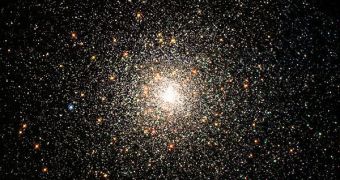Until not long ago, astronomy students were taught that globular clusters are accumulations of stats that formed from the same massive gas cloud. As such, no new stars could develop beyond the time of initial formation. This notion was however proven wrong in a new study.
The research looked at a large number of such clusters, which are lurking at the edges of the Milky Way. It was found that the structures, which contain hundreds of thousands of stars each, contain some stellar objects that appeared to be significantly younger than the others.
This is interesting because most of these clusters are about 10 billion years old, which means that their stars have certain characteristics that they share. While the most massive objects in these structures exploded a long time ago, the smaller ones share a number of traits, such as for instance their colors.
The oldest stars in the Universe tend to be red, whereas the newest stars are blue. If past theories are true, then how is it that astronomers found some blue stars among massive globular clusters filled with ancient stars?
“We thought we understood these clusters very well. We taught our students that all the stars in these clusters were formed at the same time, from one giant cloud of gas,” Dr. Alison Sills explained.
“And since that time, the individual stars may have evolved and died, but no new stars were born in the cluster,” added the expert, who is an associate professor of physics and astronomy at the McMaster University, in Canada.
The scientist presented the new findings at the CASCA 2011 meeting, which was held in Ontario, Canada, this week, Daily Galaxy reports. She explained that the oddball stars may in fact belong to a class known as blue stragglers.
They are the product of interactions between two stars, which stray too close to each other in the same cluster, Gravitational interactions eventually cause the objects to merge, uniting their material and instilling new life in the newly-formed stars. This gives it its youthful appearance.
“Astronomers expect that the stars get too close to each other because of the complicated dance that stars perform in these dense clusters, where thousands of stars are packed into a relatively small space, and each star is moving through this cluster under the influence of the gravity of all the other stars,” Sills said.
“Somewhat like a traffic system with no stop lights, there are a lot of close encounters and collisions,” she added. The new discovery will provide astronomers with additional insight into the nature of globular clusters, and also into the evolution of stars.
“Studying the normal stars in clusters was instrumental in allowing astronomers to figure out how stars lived and died, but now we can look even further back, to when they were born, by using the oddballs,” the expert reveals.
“It pays off to pay attention to the unusual individuals in any population. You never know what they’ll be able to tell you,” she concludes, quoted by Universe Today.

 14 DAY TRIAL //
14 DAY TRIAL //